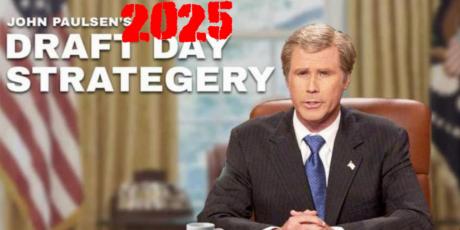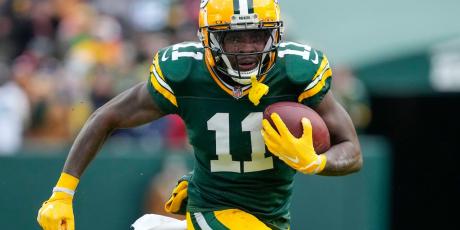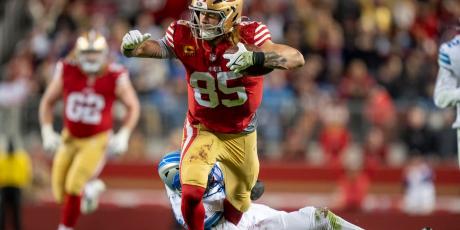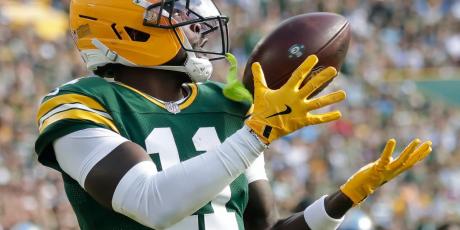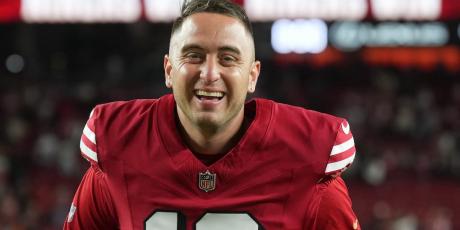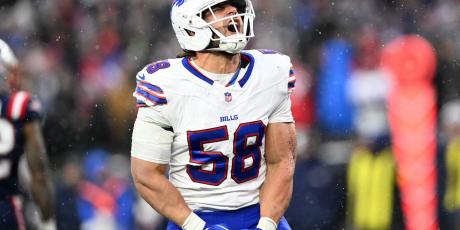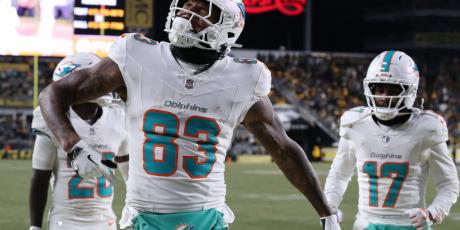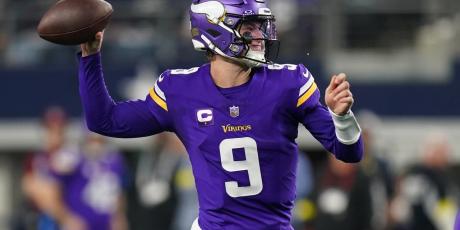Fantasy Football: Characteristics of an Early-Round Bust

As drafters, we expect our first couple of picks to be automatic, players who will sit atop any roster at the end of the season. Their contribution should be impactful, one that can be counted on every time they take the football field. Of course, it wouldn’t be fantasy football without an early-round player getting injured during the preseason or the first couple of weeks of the regular season, sending them to the sidelines for a significant amount of games, or even ending their entire season before it even began.
Still not a 4for4 subscriber? Use CODE Jen10 for 10% off any plan now!
Sadly, those premature injuries are an inevitable part of the game, something fantasy owners really can’t do anything about. But what about the guys who are drafted within the first few rounds who just don’t pan out as expected? That significant drop in points can easily be a difference-maker throughout the season, considering those players' projections were among the top in the league. If we could somehow predict which players forecasted among the first two rounds would falter, or produce much less than their expectations, we could get an edge on the competition and save ourselves some heartache along the way.

DraftKings is giving ALL customers a can't-miss offer for Best Ball: Draft One, Get One! Enter a lineup in the $15 Million Best Ball Contest for just $20, and you'll score another Best Ball ticket to play FREE for a share of $15 million—giving you a second shot to win big!
When examining the characteristics of an early-round bust, I decided to look at players selected in Rounds 1 and 2 from 2015–2024, in an attempt to find any correlations in their seasons. For this article, only WRs and RBs were used, as their sample size is much larger in these rounds, plus elite QBs and TEs very rarely bust unless they’re off the shelf due to injury. In order to get candidates with true fantasy failures, all players must have been on the field for at least 10 games that season, eliminating players with significant injuries. To qualify as a bust, players must have ended the season at least 10 spots below their positional average draft position (ADP) and/or posted at least 100 points below their projected output.
Running Backs
Just 17 backs fit the criteria outlined above from 2015 through the 2024 season, with two coming from last year.
| Player | Year | Team | G | ADP | POS ADP | END RANK (Half PPR/G) | Half-PPR POINTS/Game |
|---|---|---|---|---|---|---|---|
| Eddie Lacy | 2015 | GBP | 15 | 1.04 | RB3 | RB45 | 8.7 |
| C.J. Anderson | 2015 | DEN | 15 | 1.11 | RB6 | RB46 | 8.6 |
| Jeremy Hill | 2015 | CIN | 16 | 2.02 | RB8 | RB28 | 10.1 |
| Lamar Miller | 2016 | HOU | 14 | 1.10 | RB4 | RB18 | 12.5 |
| Jay Ajayi | 2017 | MIA/PHI | 14 | 2.02 | RB7 | RB36 | 8.8 |
| DeMarco Murray | 2017 | TEN | 15 | 2.03 | RB8 | RB24 | 10.1 |
| Clyde Edwards-Helaire | 2020 | KC | 14 | 2.06 | RB9 | RB26 | 11.3 |
| Saquon Barkley | 2021 | NYG | 13 | 1.12 | RB9 | RB34 | 9.9 |
| Clyde Edwards-Helaire | 2021 | KC | 10 | 2.08 | RB14 | RB29 | 10.8 |
| Jonathan Taylor | 2022 | IND | 11 | 1.01 | RB1 | RB18 | 12.0 |
| Najee Harris | 2022 | PIT | 17 | 1.08 | RB5 | RB19 | 11.9 |
| D'Andre Swift | 2022 | DET | 14 | 1.11 | RB7 | RB20 | 11.9 |
| Austin Ekeler | 2023 | LAC | 14 | 1.04 | RB2 | RB23 | 11.4 |
| Bijan Robinson | 2023 | ATL | 17 | 1.05 | RB3 | RB17 | 12.8 |
| Tony Pollard | 2023 | DAL | 17 | 2.04 | RB8 | RB22 | 11.5 |
| Breece Hall | 2024 | NYJ | 16 | 1.04 | RB2 | RB18 | 13.3 |
| Travis Etienne | 2024 | JAX | 15 | 2.04 | RB7 | RB44 | 7.4 |
Poor Offensive Lines, Lack of Targets, or Just Not Very Good?
Looking back at 2015, three RBs earned a spot at the early-round-underperformer table: Eddie Lacy, C.J. Anderson, and Jeremy Hill. Lacy’s ADP was an inflated 1.04 right after Adrian Peterson, Antonio Brown, and LeVeon Bell that season. What should have been an RB3 scenario ended with just 758 rushing yards and five total touchdowns—enough to finish as the RB45 in half-PPR points per contest. The Packers' offense was mediocre, finishing 15th in total offense and 27th in yards per play. Perhaps their offensive line was to blame, as Aaron Rodgers was sacked 46 times in 2015, the fifth-most in the league. Lacy’s target deficiency may have also played a part in his underwhelming numbers. With only 28 total, he ended 2015 as the 51st-most targeted RB in the NFL, something a top-tier RB rarely finds success with.
C.J. Anderson was on the Super Bowl-winning Broncos offense in 2015, yet ended the season as the RB47 in half-PPR points per game. Coming off a year where he posted RB10 numbers, Anderson’s ADP was 1.11, the sixth-highest at his position. What went wrong for the third-year back? It appears as though Denver’s porous offensive line could have played a part here, as the tandem of Peyton Manning and Brock Osweiler was sacked 39 times, the 13th-most in the NFL, inhibiting Anderson from gaining any ground. He also only averaged 11.8 touches per game, 42nd among RBs that season.
Jeremy Hill is an interesting one, as he led his offense in rushing yards and was 13th in total touches among RBs, but posted a pedestrian 3.6 rushing yards per attempt. The Bengals were first in the AFC North with a 12-4 record and ranked seventh in total offense in the league. Is it possible he just wasn’t that good at football? I’m going with yes.
Lamar Miller was the only RB in 2016 to bear the bust moniker. As the fourth RB off the board at 1.10, Miller ended the season as the RB18 in half-PPR points per game. Once again, a rough offensive line that allowed the 22nd-most sacks came into play. Having Brock Osweiler under center didn’t exactly help either. Surprisingly, Miller’s 21.4 touches per game were among the most in the league in 2016, yet he couldn’t get it done with a mediocre 4.0 rushing yards per attempt. Like the others, his targets were on the low end, ranking a disappointing 34th among backs that season.
In 2017, we saw two RBs not meet the expectations of their elevated ADPs. Jay Ajayi was drafted at the start of the second round, with an ADP of 2.02. He played for two different teams, after being traded from the Dolphins to the Eagles midway through the season. In Miami, Ajayi averaged 19.7 attempts per game only to be reduced to 10 per contest in Philadelphia. Offensive line was not an issue for either team. It appears that a lack of targets could have been his downfall. With only 34 total targets on the season, Ajayi ranked 46th at his position, as he was thrown to nearly 80 times fewer than the RB target leaders. In turn, he tumbled 29 spots in positional ADP and put up more than 100 half-PPR points fewer than projected at the start of 2017.
Similar to Hill above, DeMarco Murray’s slide seems to be more of a lack of elite talent, as opposed to a system issue. The Titans ranked 15th in rushing and 19th in total offense in 2017, clinching a Wild Card spot with their 9-7 record. We can blame some of Murray’s lack of production on his target share, as he ended the season as the RB20 in overall targets; however, he led Tennessee’s backfield, nearly tripling the number of targets that sophomore Derrick Henry saw.
In 2020, Clyde Edwards-Helaire shot up draft boards after Damien Williams opted out of the 2020 season due to COVID concerns. Based on Andy Reid's history of featuring lead backs, it was all systems go for CEH as the RB9 during draft season. The rookie did lead the Chiefs in total touches with 217 (15.5 per game) but didn't live up to expectations in fantasy land. We certainly can't blame the Chiefs' offense, as they posted the most yards and the sixth-highest point total of any unit in the league. The 23-year-old's 4.4 yards per attempt was 27th among ball carriers, and his rushing yards after contact ranked 19th. He wasn't awful, but he just wasn't worthy of a mid-second-round pick.
2021 brought just one guy on a really bad offense, Saquon Barkley, and CEH was back in the mix for the second-straight season. I'll start with our repeat offender, Edwards-Helaire, as he ended the season 15 positional spots below his ADP and nearly 100 half-PPR points behind backfield mate Darrel Williams. CEH did miss seven games due to injury, but when on the field, didn't really shine either as a runner or pass catcher. In fact, when he returned late in the season, the Chiefs gave more work to journeyman Jerick McKinnon, who out-touched CEH 33 to 17 during the postseason, presumably the most important games of the year.
The Giants were a complete disaster in 2021, dysfunctional in every sense of the word. Barkley did manage to play for 13 games but was much less involved in the passing game than in his previous seasons, with just 57 targets, compared to 73 and 121 in the past. While definitely a bust as the RB34 in half-PPR points per contest, Barkley shouldn't field all of the blame for the brutal season, as the New York o-line was among the bottom of the barrel in nearly all statistical categories, including 31st in blown block percentage.
In 2022, we added three RBs to this not-so-illustrious list. Jonathan Taylor was the 1.01, and with that, he was obviously the first RB off draft boards. Two major factors led to Taylor's bust campaign, the first being an ankle injury the 24-year-old nursed for the majority of the season, which eventually led to surgery at the end of January. Taylor managed just 861 yards and 11 touchdowns in 11 contests, but was also running behind one of the worst offensive lines in the NFL. The combo of Matt Ryan, Sam Ehlinger, and Nick Foles was sacked 60 times, which was second among offenses for a total of 422 yards (1st).
Najee Harris probably should not have boasted such a high ADP heading into 2022, as he entered the season with a Lisfranc issue and was rushing behind 4for4's 27th-ranked offensive line. His QB situation wasn't ideal either, with Mitch Trubisky and rookie Kenny Pickett duking it out to replace Ben Roethlisberger. It was a disaster of inefficiency for Harris in 2022 as he posted a mere 3.8 yards per carry, 1.6 yards before contact per carry, and 1.7 yards after contact per carry. In the second half of the season, as Pickett improved, Harris' fantasy output did as well, as he posted RB7 numbers in half-PPR points per game with 14.2 from Weeks 10-18.
The 2022 season was a roller coaster for D'Andre Swift and his drafters as he started out white hot, but got hurt after Week 3 and upon return in Week 8, was in the opportunity dog house and never regained the featured-back role. The 24-year-old was actually efficient when he had the ball, ending fifth in yards per carry and seventh in rushing EPA per carry, but his lack of touches - just 10.5 per game as RB49 - and just five end zone appearances killed his draft value.
2023 brought three more additions to the early-round RB bust list. The Chargers' offensive line wildly underperformed, which didn't do Austin Ekeler any favors, and he had a rough year in terms of production. An ankle sprain in Week 1 sidelined the RB for three weeks and likely hindered his volume and output for the remainder of the season. Upon return in Week 5, Ekeler saw just 16.2 touches per game (23rd among RBs) and never eclipsed 67 rushing yards with an average combined yards per game of 69.2. LA was 24th in rushing attempts on the season with the 25th most ground yards.
We all had such high hopes for Bijan Robinson in his rookie season that he was being drafted in the first half of Round 1 by September. Former Atlanta HC Arthur Smith had his fingerprints all over this "bust" as Robinson sat 27th among RBs in touches per game (15.3), and he was also 37th in rushing attempts within the red zone, while teammate Tyler Allgeier sat 23rd in that last category.
It should be no surprise to see Tony Pollard on this list. Given the reins to the Cowboys' backfield prior to the season, he was the eighth RB off draft boards in the second round, yet ended as the RB22 in half-PPR points per contest. Pollard's inefficiency took him down in 2023, as he saw the second-most red zone opportunity behind only Christian McCaffery (83), yet scored on just five of those 72 looks. As a Cowboy in 2023, Pollard ended 20th in rushing yards per game and 29th in yards after contact per carry (among RBs with a minimum of 70 carries).
Last year, only two backs fit the criteria for this article. Breece Hall was coming off an RB7 campaign in half-PPR scoring on a per-game basis, and his ADP rocketed up to RB2 as the fourth overall selection in 2024. The Jets ranked 25th in total offense and had the 31st rushing offense in the NFL. New York's o-line didn't exactly help things, as Aaron Rodgers was sacked 40 times, which was the ninth most, but Hall himself deserves some blame for the down year, as he posted just 4.2 yards per attempt (29th), the lowest of his career. His yards after contact (YAC) were a site-friendly 444, which came out to 2.1 per attempt, 20th among backs in both metrics. Not surprisingly, after reading all that, Hall ended as the RB18, with just 13.3 half-PPR points per tilt.
Travis Etienne was a huge disappointment in 2024, checking in a whopping 37 positional spots lower than his draft stock. He dealt with both shoulder and hamstring issues early in the season, but after missing Weeks 7-8, he played the remainder of the schedule. His inefficiency last year was glaring as the Jag averaged just 1.8 yards after contact per attempt, which was below the league average of 1.9, and he posted just .48 fantasy points per touch, which sat 97th among NFL RBs last season. Etienne had a mere three broken tackles on rushes in 2024, a number that sits below QBs Will Levis and Daniel Jones. So yeah, he wasn't great.
The Jets drafted another tackle early this year, which should help Hall, but rumors of a committee have been circulating all offseason. A report from The Athletic's Zack Rosenblatt from mid-June indicated that the Jets don't have an obvious passing option after Garrett Wilson outside of Hall, which could also mean a top-15 workload in 2025. 4for4's Multi-Site ADP tool has him as the RB13 at pick 32, which seems like an accurate price tag. Etienne's draft stock has fallen significantly in 2025, thanks to his inefficiency in two straight seasons, plus the presence of Tank Bigsby and rookie speedster Bhayshul Tuten. There's still plenty of time for the hierarchy in the RB room to shake out, and Etienne could end up as the Jags RB1, but for now, he's being drafted as a fantasy RB4 in the 10th round and is 4for4's RB38.
Wide Receivers
There were 20 wideouts who earned the chance to hear Maury Povich say "You are not a WR1" from 2015-2024, and here’s a look at how they potentially got there.
| Player | Year | Team | G | ADP | POS ADP | END RANK (Half PPR/Game) | Half-PPR POINTS/Game |
|---|---|---|---|---|---|---|---|
| Randall Cobb | 2015 | GBP | 16 | 2.04 | WR7 | WR33 | 10.2 |
| DeAndre Hopkins | 2016 | HOU | 16 | 1.06 | WR5 | WR37 | 9.9 |
| Allen Robinson | 2016 | JAX | 16 | 1.09 | WR6 | WR34 | 10.1 |
| Brandon Marshall | 2016 | NYJ | 15 | 2.01 | WR7 | WR56 | 8.4 |
| Alshon Jeffery | 2016 | CHI | 12 | 2.10 | WR13 | WR36 | 10.0 |
| Mike Evans | 2017 | TBB | 15 | 1.08 | WR4 | WR20 | 11.0 |
| Jordy Nelson | 2017 | GBP | 15 | 1.11 | WR6 | WR53 | 7.4 |
| Dez Bryant | 2017 | DAL | 16 | 2.08 | WR9 | WR33 | 9.5 |
| Amari Cooper | 2017 | OAK | 14 | 2.09 | WR10 | WR32 | 9.6 |
| JuJu Smith-Schuster | 2019 | PIT | 12 | 2.03 | WR5 | WR63 | 7.7 |
| Odell Beckham | 2019 | CLE | 16 | 2.03 | WR6 | WR35 | 10.3 |
| Adam Thielen | 2019 | MIN | 11 | 2.12 | WR10 | WR48 | 9.0 |
| DeAndre Hopkins | 2021 | ARI | 10 | 2.05 | WR4 | WR18 | 12.6 |
| DK Metcalf | 2021 | SEA | 17 | 2.08 | WR6 | WR20 | 12.2 |
| Deebo Samuel | 2022 | SF | 13 | 2.09 | WR7 | WR26 | 10.8 |
| Garrett Wilson | 2023 | NYJ | 17 | 2.09 | WR9 | WR40 | 9.7 |
| Jaylen Waddle | 2023 | MIA | 14 | 2.10 | WR11 | WR24 | 11.6 |
| Tyreek Hill | 2024 | MIA | 17 | 1.02 | WR1 | WR32 | 10.5 |
| Garrrett Wilson | 2024 | NYJ | 17 | 1.12 | WR7 | WR22 | 11.8 |
| Marvin Harrison Jr. | 2024 | ARI | 17 | 2.03 | WR9 | WR41 | 9.7 |
Bad Offenses, Bad QBs, and Straight Up Bad Play
Randall Cobb, who was the seventh WR off the board at 2.04, is the lone receiver bust in 2015. Instead of a top-10 finish, the Packers' WR ended the year as the WR27 in half-PPR points, averaging just 10.2 per game. Despite having arguably one of the greatest QBs in the NFL under center, Green Bay’s passing offense ranked 25th in 2015, with Rodgers personally sitting as the QB30 in yards per attempt and 26th in completion percentage. Can we blame Cobb’s slippage on the poor play of Rodgers in 2015? I think I just did. His wideout didn't exactly help, though, as Cobb posted a paltry 51.8 reception yards per game, and his 61.2% catch rate was 124th among pass-catchers.
Four WRs didn’t make the grade in 2016: DeAndre Hopkins, Allen Robinson, Brandon Marshall, and Alshon Jeffery. One thing all four have in common? Brutally bad offenses. In Hopkins’s case, the Texans actually won the AFC South and a playoff game, but still managed to end the season ranked 29th in both team and passing offenses. Brock Osweiler’s 2.9% TD rate was just two away from dead last among QBs, and he owned the basement spot in yards per attempt. Even with Nuk’s insane talent, one can’t overcome dreadful QB play.
While not in the same situation when it came to his team’s end-of-season result, Robinson met the same fate in the QB department. The Jaguars went 3-13 in 2016, with the NFL’s 25th-ranked team offense. Even all the garbage time theatrics couldn’t elevate Blake Bortles from his post as the third-worst QB both in yards per attempt and completion percentage. ARob dropped 28 spots from his WR6 ADP to where he eventually finished the season in half-PPR points per game as the WR34.
The Jets were a smidge better record-wise in 2016, yet still struggled offensively. With Ryan Fitzpatrick as the signal-caller, New York’s team offense ranked 30th, with the 27th-ranked passing offense. The NFL’s journeyman extraordinaire sat within the bottom four of almost all passing categories from 2016, including yards per attempt, adjusted yards per passing attempt, TD rate, and completion percentage. Marshall was the seventh WR off the board at 2.01 and brutally finished as the WR56 in half-PPR points per tilt. His output was nearly 100 points fewer than projected for a wideout at his ADP.
It seems Jeffery was also a casualty stemming from a poor Bears QB committee in 2016. The insipid trio of Matt Barkley, Brian Hoyer, and Jay Cutler combined for a 3.2% TD rate, good enough for 24th among QBs that season. While Jeffery did miss four games due to a banned substance violation, he was still at the lower end of the league in production when on the field. His 4.3 receptions per game ranked 48th, while his 55.3% catch rate came in at a disappointing 157th among receivers.
In 2017, we saw another four WRs within the top 10 taken at their position who failed to finish in that same elite category. Mike Evans is sort of a head-scratcher, as the Bucs' passing offense was ranked fourth in the NFL in 2017. He was the top fantasy producer in his offense, yet he ended the season as the WR20 in half-PPR points a game. Jameis Winston missed three games but was fairly effective while on the field, ranking within the top 10 in the majority of QB statistical categories. Evans seems to have gotten in his own way in 2017, as his 52.2% catch rate was 182nd among pass-catchers. Also, despite finishing 11th at his position in targets, he averaged only 4.7 receptions per game.
Jordy Nelson had Brett Hundley tossing the rock for 11 games, translating to a 25th-ranked passing offense for the Packers in 2017. While on the field, Hundley was the fourth-worst in TD rate, second-worst in yards per attempt, and ranked 23rd in completion percentage. Rodgers’ numbers were up to par for his standard of play, but that can only go so far in just seven games. Nelson didn’t exactly make lemonade from the Hundley situation, as his catch rate was a disappointing 60.2% (130th among pass-catchers). His drop from WR6 to WR53 was a huge one, as his final output was over 100 PPR points fewer than projected during draft season.
People are still arguing if Dez Bryant’s fall stemmed from a sophomore slide by QB Dak Prescott or simply a loss in step from the veteran wideout. Prescott’s numbers were serviceable, ranking 13th in completion percentage, 19th in yards per attempt, and 16th in total passing yards. However, Bryant’s numbers weren’t so favorable. His 52.3% catch rate ranked 179th among all pass-catchers, while his 12.1 yards per reception ranked 59th. The targets were there, as Bryant posted WR12 numbers in that department, but in the end, he finished as the WR24 in total half-PPR points—15 spots away from his draft day ADP.
Amari Cooper ended the season 22 spots from his WR10 ADP, with an 81-point differential than projected at the start of 2017. What went wrong for the third-year wideout? Derek Carr’s back injury affected him more than he let on, and their 23rd-ranked offense suffered as a result. Carr sat in the lower half of the league in nearly every statistical category, which makes it tough for a WR to achieve elite fantasy status. Cooper was also second to Michael Crabtree in targets with 96 and fourth on the Raiders’ offense in target rate per snap. His 50% catch rate didn't exactly help him, as it put him 190th in the league among receivers.
After taking 2018 off, three wideouts were deemed busts in 2019 based on our criteria. Falling 58 spots from WR5 to WR63, JuJu Smith-Schuster broke many fantasy hearts in his first year as the Steelers' top dog. He was unable to stay healthy, which didn’t help, but the 23-year-old was the victim of a really bad QB bounce, having to catch passes from Mason Rudolph and Devlin Hodges for all but two contests. Pittsburgh was 27th in total offense and ranked 31st in passing, which is tough to overcome for any WR.
The hype was pretty massive surrounding Odell Beckham and the Browns heading into 2019, and as a result, OBJ was an early second-rounder as WR6. Cleveland’s offense did not produce as expected due to a myriad of reasons, with a subpar offensive line certainly among them. They ranked 23rd at the end of 2019, and their ineptitude had a hand in the Browns' offense ending as the 22nd-ranked passing offense. Baker Mayfield also took a step back, which didn’t help, posting a 59% completion rate (30th in the NFL) and a 4.1% TD rate, which was in the lower third of the league.
Thielen dropped from WR10 in ADP to a WR48 finish in half-PPR per contest scoring. He was only in a uniform for 11 games due to a soft-tissue injury as well as an ankle laceration, but the Vikings went way run-heavy on the season (fourth in the league) even when he was in the game. His catch rate of 62.5% was 135th among pass catchers, which was not ideal. The 29-year-old was a disappointment for those who spent a late-second-round pick on him as Thielen failed to crack 100 half-PPR points all season long.
Barely qualifying due to injury and only hitting the field 10 times, DeAndre Hopkins fell 14 WR spots from his WR4 ADP in 2021. His team WR1 status and volume took a monster hit from 2020 to 2021, as he saw 10.0 targets per contest in 2020 to Christian Kirk's 5.6, which dipped down to 6.4 in 2021 with Kirk seeing a similar 6.3 balls per tilt.
DK Metcalf shouldn't necessarily shoulder too much blame for his down 2021 season, as Russell Wilson spent Weeks 6-8 on IR due to a surgically repaired finger and was never really the same upon his return. Seattle was 31st in the NFL in pass attempts and 29th in completions, and subsequently, Metcalf's fantasy production took a dive from 14.4 half-PPR points a game in 2020 to 12.2.
Just one WR made this column from 2022, and it was 2021's WR2 in both overall half-PPR points and per-game, Deebo Samuel. The addition of Christian McCaffrey took away Samuel's hybrid role in the 49ers' offense, and his volume took a hit, along with his production. The 27-year-old's yards per catch dropped from 18.2 in 2021 to 11.3, and he battled ankle, knee, and hamstring issues on his way to 632 yards on 56 receptions, with another 42 rushes for 232 yards.
Bad QB play was the name of the bust game in 2023 for Garrett Wilson, as he was being drafted with the assumption that Aaron Rodgers would be on the field for more than three minutes. Instead, he caught balls from the vanilla trio of Zach Wilson, Trevor Siemian, and Tim Boyle. With a 25% target share and 43% air yards share, which sat second in the NFL, Wilson flashed potential. Jaylen Waddle posted over 1,000 yards on 104 targets in 14 contests in 2023, but only found the end zone four times all season. He wasn't a huge disappointment, but did finish 13 positional spots below his WR11 ADP, so he counts for this study.
Speaking of bad QB play, Tyreek Hill tops the list of WR busts from 2024. Well, we can't blame it all on Tua Tagovailoa, but he was injured for six contests and had the lowest air yards per attempt (5.8) in the NFL last season. Hill did suffer a wrist injury in Week 1 that lingered, but he only had three contests with over 100 receiving yards last year and ended as the WR32 in half-PPR scoring on a per-game basis. The Cheetah is now 31 years old, but he's still speedy, and Tagovailoa is healthy, so sleeping on him could be a mistake. Recency and age bias have depressed Hill's ADP to 3.12 as the WR16.
We have a repeat offender alert as Garrett Wilson is here again, this time with Rodgers as his QB all season long. He did post career highs in receptions (101), receiving yards (1,104), and receiving touchdowns (7), but did have to compete with Rodgers' bestie Davante Adams for targets. If the Jets lean very run-heavy, which is the expectation, we could see Wilson here for a threepeat, but it's unlikely simply because his ADP is currently outside the top 24 as the WR14 (3.07), but he does have the potential for fantasy WR2 output under this new Jets coaching staff as the clear WR1.
I would like to point out what I wrote in this very column last June, before I get into this next guy.
Marvin Harrison Jr. will likely have an incredible NFL and fantasy career and may even be solid for rosters in 2024, but with an ADP of 15, he's the highest rookie WR we've seen drafted maybe ever, despite landing in an Arizona offense that's 22nd in projected points this season. The Cardinals attempted 555 passes in 2023, which sat 24th among the league's offenses, and were 29th in pass rate over expected (PROE) and 30th in pass percentage when in neutral game script. Harrison would have to be an absolute beast with a huge step forward (or backward to 2021) from Kyler Murray to return his current draft capital.
Yes, I am fully tooting that horn of mine, but Marvin Harrison Jr. did not even come close to paying off for drafters, as he finished as WR41. The then-rookie was used as a field stretcher to open things up for Trey McBride. which was great for the Arizona offense, but his utilization was rough for any meaningful production. MHJ has put on some muscle mass this offseason, which should assist in contested catches, and hopefully they get him more involved in the intermediate and short stuff in 2025. Harrison is 4for4's WR19 and also boasts an aggregate ADP of WR19 at pick 4.04
Potential 2025 Busts
I know it's sacrilegious to go against Christian McCaffrey, but I'll take my chances. Yes, he's "fully healthy" after bilateral Achilles tendonitis and a PCL sprain in his knee, and yes, the 49ers have fewer weapons than they have had in previous years. However, we won't get any coach or trainer to say that he's not having great workouts or is not going to be his old self in 2025. That's a wait-and-see thing for all of us. CMC will be 29 at the start of the season, and he's seen a lot of wear and tear on his body with a whopping 1,871 career touches in eight seasons. I liked him a lot better earlier this summer when he was a second-rounder, but after healthy camp reports are making the rounds. McCaffrey is leaving boards at 1.11 as the RB5. John Paulsen has him a bit more conversatively at RB7 in our ranks.
Bottom Line
- If drafting a running back in the first few rounds, which seems on trend again for this season, be sure to check out their offensive line. It’s tough to produce if the offense can’t get a play off and their quarterback is on the ground. Also, targets matter. They always matter.
- Wideouts are only as good as the quarterback throwing them the ball, regardless of freakish talent. Sure, athletic ability can get them so far, but to count on the numbers expected from an early-round draft pick, the signal-caller under center is certainly a factor. Look for solid quarterbacks in respectable offenses.
- Let your league mates grab the big names in not-so-great situations and instead focus on players who are set up for success, not only physically, but by the competency of their teammates.


